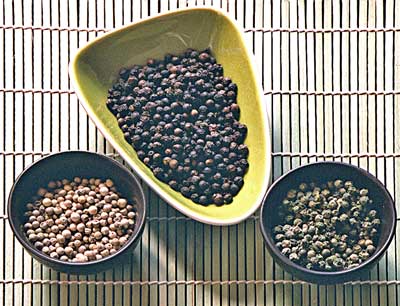"Guinea pepper." A spice from Africa sometimes used as a mild pepper substitute and with a flavour slightly reminiscent of cardamon. The pods are crushed and added whole to soups or stews, then removed before serving any food.
A name in Tuscany for a peperoncino, a small red hot chilli from the south of Italy and used much in its cuisine. It is grown in huge quantities in Basilicata, the Marche and Calabria.
A name in Abruzzo for a peperoncino, a small red hot chilli from the south of Italy and used much in its cuisine. It is grown in huge quantities in Basilicata, the Marche and Calabria.

Black peppercorns, the fruit of a perennial vine with large leaves and white flowers. Green peppercorns are the unripe fruits picked early and pickled. Black peppercorns are picked just before they ripen and white peppercorns are the ripe, black peppercorns with the black skin flaked off. They are best kept whole and ground when required. Historically, pepper was one of the world's most important spices. Columbus sailed West, not East, in search of pepper in the East Indies. Instead he found the Americas and allspice.
"Peppery." A rich, demi-glace type sauce made with bone marrow and seasoned with lots of pepper and served wth meats or poultry.
Red and yellow peppers stewed with tomato, onion and green olives, garlic and oregano found especially in the south of Italy. May be served with pasta.
Italian peporincini are mild red chillis, similar to Anaheims in many ways. The larger varieties may be used as a vegetable while the smaller ones, often long and pointed, can pack quite a punch. They are used for seasoning, whether dry or fresh, but are milder than South American chillis or cayenne pepper. They are grown in huge quantities in the south in Basilicata, the Marche and Calabria and are used in much of their cuisine. The varieties found in the South include the devilish diavolicchio.